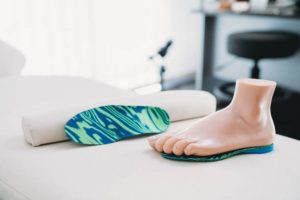When you suffer from pain in your feet, you might be wondering if it is time to see a podiatrist. If so, you are not alone! Many people also suffer from neuromas, bunions, and ingrown toenails. Regardless of your situation, there are many benefits to seeing a podiatrist. Here are a few of them.
Ingrown toenails
 Whether you are suffering from a mild case of ingrown toenails or you’ve noticed an infection, there are several benefits to seeing a podiatrist for an ingrown toenail. Even though you may think that soaking your foot in warm water will cure your ingrown toenail, this is usually ineffective. You can also try using an Epsom salt soak or give yourself a foot massage. Ingrown toenail treatment should begin within a week of the symptoms occurring.
Whether you are suffering from a mild case of ingrown toenails or you’ve noticed an infection, there are several benefits to seeing a podiatrist for an ingrown toenail. Even though you may think that soaking your foot in warm water will cure your ingrown toenail, this is usually ineffective. You can also try using an Epsom salt soak or give yourself a foot massage. Ingrown toenail treatment should begin within a week of the symptoms occurring.
Your podiatrist can determine if your ingrown toenail is causing pain; if so, they can help you achieve the desired results. A podiatrist will not only diagnose your problem but will also recommend the most appropriate treatment. In rare cases, an ingrown toenail can lead to gangrene, a potentially fatal infection. Depending on the severity of your case, you may require a minor surgical procedure.
If you have a compromised immune system, you should visit a podiatrist as soon as possible to address your ingrown toenail issue. Moreover, you should seek medical care immediately if you suspect you have diabetes or nerve damage. Ignoring this condition can lead to infection and other potentially dangerous complications. Visiting a podiatrist for an ingrown toenail can help alleviate pain and speed up healing.
Bunions
Seeing a podiatrist for bunions is beneficial in several ways. Firstly, it will enable your foot to heal more quickly and fully. Secondly, a physiotherapist will offer a range of treatments that target specific conditions and help improve your quality of life and strength. Lastly, a physiotherapist will assess your bunions during consultation and look at the lumbar spine and the bones of your lower limbs to determine if they are misaligned.
When you first notice the symptoms of a bunion, you should seek immediate medical attention from an expert in podiatry SA. Often, the pain caused by the bunion is only mild, but if it is chronic and affecting your daily life, seeing a podiatrist is essential to prevent the condition from worsening. In some cases, the bunion pain is so severe that it will prevent you from moving your feet.
Neuromas
The benefits of visiting a podiatrist for neuromas are numerous. Early diagnosis will allow treatment to begin before symptoms worsen. Treating neuromas can range from resting the foot, icing it, and applying pressure to relieve pain. Patients should also wear thick-soled shoes to reduce pressure on the foot. Custom orthotics can also be prescribed to relieve pressure on the affected area.
Neuromas typically affect women and are caused by excessive pressure on the toes. Pain while walking is one of the most common symptoms. People with neuromas often experience a burning or tingling sensation in their toes. This painful sensation can ease with simple rubbing. Often, women will notice a tingling or burning sensation when they wear shoes that are too tight.
Although the cause of neuromas is unknown, it is believed to be nerve inflammation. Inflammation of a nerve may cause the formation of fibrous thickening. The foot’s biomechanics can also contribute to neuromas. A good podiatrist can identify the location and type of neuroma to provide the best treatment plan.
While there is no single cause for neuromas, people with certain foot deformities are more likely to develop them. If left untreated, neuromas can worsen over time. Neuromas can also be caused by wearing shoes that have narrow-toe boxes. These shoes can cause pain and inflammation. However, if the pain persists, it’s time to visit a podiatrist.
Prescription shoe inserts
While many people can get prescription shoe inserts at a drugstore, they often do not offer the same level of comfort and support as custom orthotics. A podiatrist can prescribe a shoe insert that will be moulded to your foot and fit perfectly. This medical device is a good solution for many foot problems, such as flat feet, heel pain, and plantar fasciitis.
Over-the-counter shoe inserts are not the best option for those with circulation problems or diabetes. These conditions increase the risk of foot ulcers and infections, and over-the-counter shoe inserts may not provide the proper support and cushioning. In addition, it’s best to consider what type of activity you engage in and which type of shoe insert will suit your needs. A podiatrist can help you select the right shoe inserts to avoid health risks.
A podiatrist can assess your overall health and determine whether or not your shoes are contributing to your problem. For example, non-prescription shoe inserts can help cushion your feet and support flat arches. However, they cannot correct biomechanical foot problems caused by biomechanical issues. A podiatrist can also prescribe orthotic inserts, which are custom-made for your feet.